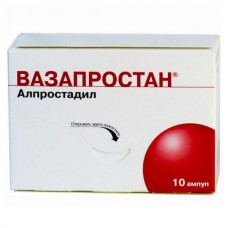Expiration date: 02/2026
Composition and form of issue:
Lyophilizate for preparation of infusion solution (48, 2 mg), 1 ampoule contains:
alprostadil (in combination with alfadex) 20 µg
excipients: lactose alphadex
in carton 1 contour cell pack with 10 vials.
Characteristic:
Lyophilisate white assembled on the bottom of the ampoule, forms a layer with a thickness of about 3 mm. After complete dissolution of the lyophilisate in physiological solution is a clear, colorless liquid.
Pharmacological action:
The drug PGE1 improves microcirculation and peripheral blood circulation, has a vasoprotective effect. With systemic administration, it causes relaxation of smooth muscle fibers, has a vasodilating effect, reduces OPSS without changing blood PRESSURE. In this case, there is a reflex increase in cardiac output and heart rate. It helps to improve the elasticity of red blood cells, reduces platelet aggregation and neutrophil activity, increases fibrinolytic activity of the blood. It has a stimulating effect on the smooth muscles of the intestine, bladder, uterus suppresses the secretion of gastric juice.
Pharmacokinetics:
PGE1 used in combination with alpha-cyclodextrin in/in or/as. During the preparation of the solution complex of the drug disintegrates into its component parts — PGE1 and alpha - cyclodextrin. When in/in the therapeutically significant concentration of the active substance is achieved shortly after the start of the drug, and Cmax in the blood plasma — for 2 hours from the beginning of the introduction. PHE 1 is an endogenous substance with an exceptionally short T1 / 2 — plasma concentration returns to the initial level for 10 seconds after discontinuation of administration. The process of biotransformation PGE 1 occurs mainly in the lungs, in the "first pass" through the lungs is metabolized in 60-90% of the active substance with the formation of the major metabolites, 15-keto — PGE1, 15 - keto — PGE0 and PGE0. The main products of metabolism are excreted by the kidneys-88% and through the gastrointestinal tract-12% for 72 hours. plasma proteins are bound 93% PGE1. Alpha-cyclodextrin has a T1/2 approximately 7 min, displayed kidneys in an unmodified form.
Indications:
Chronic obliterating diseases of arteries of III and IV stages (according to the classification of Fontaine).
Contraindications:
Increased sensitivity to alprostadil and other components of the drug, chronic heart failure, severe heart rhythm disorders, exacerbation of coronary artery disease, myocardial infarction (over the next 6 months), pulmonary edema, infiltrative lung disease, chronic obstructive pulmonary disease, liver dysfunction (elevated levels of AST, ALT or GGT) and liver disease in history, as well as diseases accompanied by an increased risk of bleeding and hemorrhages (gastric ulcer or duodenum, severe damage to the cerebral vessels, proliferative retinopathy with a tendency to bleeding, extensive trauma, etc.), concomitant therapy with vasodilators and anticoagulants, pregnancy, breastfeeding.
Use during pregnancy and breast-feeding:
Contraindicated in pregnancy. At the time of treatment should stop breastfeeding.
Side effect:
From the nervous system: headache, convulsive syndrome, dizziness, increased fatigue, feeling of malaise, violation of skin and mucous membranes.
From the cardiovascular system: reduced blood PRESSURE, chest pain, heart rhythm disorders, AV blockade.
From the digestive system: discomfort in epigastralna area, diarrhoeal phenomenon, diarrhoea, nausea, vomiting.
On the part of the musculoskeletal system: hyperostosis of long tubular bones (in the treatment of more than 4 weeks).
Local reactions: pain, edema, erythema, sensitivity disorder, phlebitis (proximal to/in the introduction).
Laboratory findings: leukocytosis, leukopenia, increased titer of C-reactive protein, increased level of transaminases.
Other: increased sweating, hyperthermia, swelling of the limb, in the vein of which the infusion is carried out.
Rarely: joint pain, confusion, seizures of Central origin, fever, chills, bradypnea, arthralgia, psychosis, renal failure, anuria. Several cases of pulmonary edema and acute left ventricular failure have been reported.
Extremely rare (1% of cases): shock, acute heart failure, hyperbilirubinemia, bleeding, drowsiness, bradypnea, reduced respiratory function, tachypnea, anuria, impaired renal function, hypoglycemia, ventricular fibrillation of the heart, AV blockade II degree, supraventricular arrhythmia, muscle tension neck, irritability, hypothermia, hypercapnia, flushing of skin integument, hematuria, peritoneal symptoms, tachyphylaxis, hyperkalemia, thrombocytopenia, anemia.
Allergic reactions: skin rash, itching.
Side effects associated with the use of the drug or with the procedure of catheterization, disappear after dose reduction or cessation of infusion.
Drug interaction:
Vazaprostan can enhance the effect of antihypertensive drugs, vasodilators and antianginal agents. Concomitant use of Vazaprostan in patients taking drugs that prevent blood clotting (anticoagulants, platelet aggregation inhibitors) may increase the likelihood of bleeding. In combination with cefamandole, cefoperazone, and cefotetan with thrombolytic drugs increases the risk of bleeding. Sympathomimetics — epinephrine, norepinephrine, reduces vazodilatiruushimi effect.
It should be borne in mind that drug interactions are possible in the event that the above drugs were used shortly before Vazaprostan therapy was started.
Dosage and administration:
In/and the introduction. Dissolve the contents of 1 ampoule of Vazaprostan lyophilizate (corresponds to 20 micrograms of alprostadil) in 50 ml of saline.
In the absence of other requirements, half of the contents of the vial Vazaprostan (corresponds to 10 µg alprostadil) is injected into the/a for 60-120 minutes when using an infusion device. If necessary, especially in the presence of necrosis, under strict control of tolerability, it is possible to increase the dose to 20 µg of alprostadil (content of 1 ampoule). This dosage is usually used for a single daily infusion.
If I / a infusion is carried out through the injected catheter, depending on the tolerability and severity of the disease, a dose of 0, 1-0, 6 ng/kg/min with the introduction of the drug for 12 hours when using the infusion device (corresponds to 0, 25-1, 5 vials of Vazaprostan).
The on/in infusion. Dissolve the contents of 2 vials lyophilisate Vazaprostan (corresponds to 40 µg alprostadila) in 50-250 ml of physiological saline solution and injected the resulting solution V/V for 2 hours 2 times daily or 3 capsules (60 mg alprostadila) for 3 hours 1 time a day.
In patients with impaired renal function (renal failure when creatinine level more than 1. 5 mg/DL)/introduction begin with 20 mcg for 2 h. If necessary, after 2-3 days, a single dose of 40-60 mcg.
For patients with renal and heart failure, the maximum volume of injected fluid is 50-100 ml / day. The course of treatment - 4 weeks.
The duration of treatment-an average of 14 days, with the positive effect of treatment with the drug can continue for another 7-14 days. In the absence of a positive effect within 2 weeks from the start of treatment, further use of the drug should be discontinued.
Solution preparation. Prepare the solution must be immediately before the infusion. Lyophilizate dissolves immediately after the addition of saline. At the beginning of the solution can get milky-muddy. This effect is created by air bubbles and does not matter. After a short time the solution becomes transparent. Do not use a solution prepared more than 12 hours ago.
Overdose:
Symptoms: reduced blood PRESSURE, increased heart rate. It is possible to develop vasovagal reactions with pale skin, increased sweating, nausea and vomiting, which can be accompanied by myocardial ischemia and symptoms of heart failure, as well as pain, swelling and redness of the tissue at the site of infusion.
Treatment: it is necessary to reduce the dose or stop the infusion. With a marked decrease in blood PRESSURE, the patient in the lying position needs to lift his legs. If symptoms persist, sympathomimetics should be used.
Precautionary measures:
With caution, Vazaprostan is used in arterial hypotension, cardiovascular insufficiency (special attention should be paid to the control of the volume of the carrier solution), in patients on hemodialysis (treatment with the drug should be carried out in the postdialysis period), in patients with type 1 diabetes, especially with extensive vascular lesions.
Vazaprostan can affect the ability to actively participate in traffic or control mechanisms, especially at the beginning of treatment, with increasing doses and the abolition of the drug, as well as while taking alcohol.
Special instruction:
Alprostadil can be used only by doctors with experience in angiology, familiar with modern methods of continuous monitoring of the cardiovascular system and having the appropriate equipment for this.
During the treatment period, it is necessary to control blood PRESSURE, heart rate, biochemical parameters of blood, blood coagulation system (with violations of the blood coagulation system or with simultaneous therapy with drugs that affect the coagulation system).
Patients with coronary heart disease, as well as patients with peripheral edema and renal dysfunction (serum creatinine >1, 5 mg/DL) should be monitored in the hospital during treatment with Vazaprostan for 1 day after discontinuation of its use.
In order to avoid the symptoms of hyperhydration in patients with renal insufficiency, the volume of injected fluid should not exceed 50-100 ml/day, if possible. It is necessary to monitor the dynamic state of the patient: control of blood PRESSURE and heart rate, if necessary — control of body weight, fluid balance, measurement of Central venous pressure or echocardiographic studies.
Phlebitis (proximal to the site of administration), as a rule, is not a reason for discontinuation of therapy, signs of inflammation disappear after a few hours after the end of the infusion or change the place of administration of the drug, specific treatment in such cases is not required. Catheterization of the Central vein allows to reduce the frequency of manifestation of this side effect of the drug.
If the ampoule is damaged, the lyophilizate becomes wet and sticky, and greatly decreases in volume. In this case, the drug can not be used.


